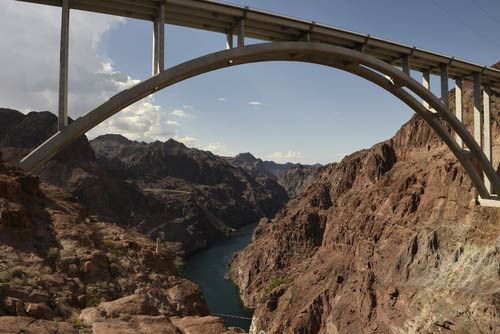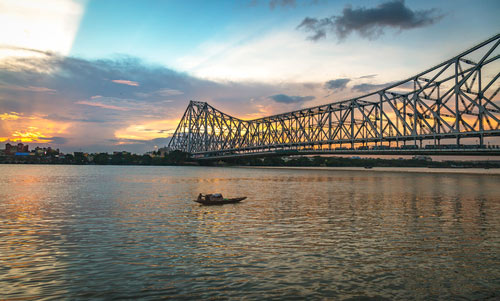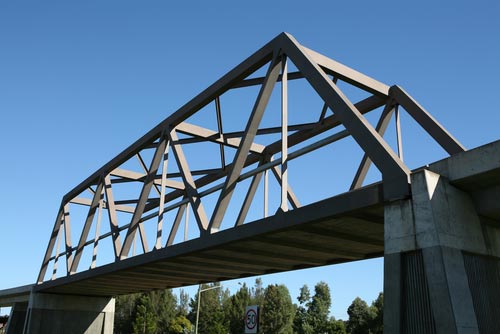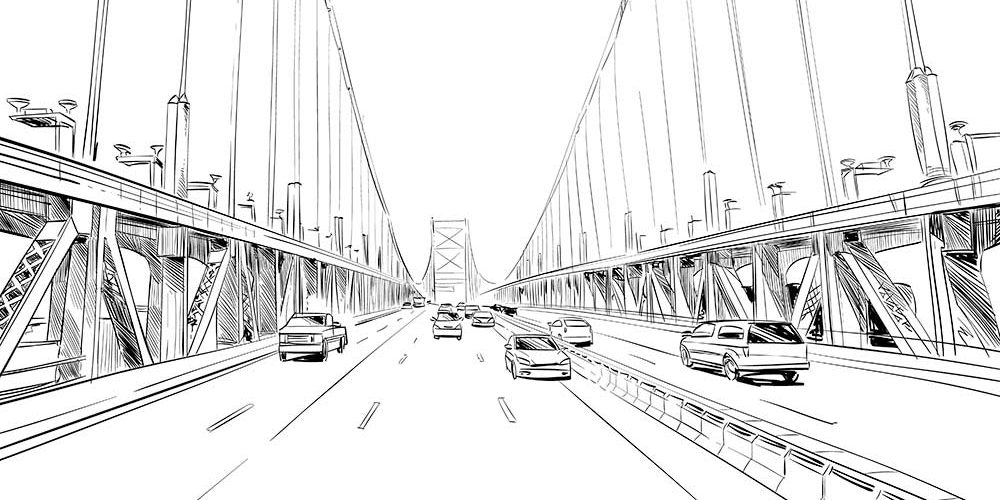Thousands of years ago, pre-humans built the first bridge. It was a simple log or boulder placed over a small stream or ravine. It would have helped keep the feet of nomads dry while traveling from one location to another.
Bridges have gotten much more complicated since then. That’s why we’ve compiled this glossary of 20 of the most common structural components used on bridges.
Abutment: Abutments are the elements at the ends of a bridge, which provide support for it. They absorb many of the forces placed on the bridge and act as retaining walls that prevent the earth under the approach to the bridge from moving.
Arch: An arch is a curved structure that spans an open space. Bridges featuring arches were among the earliest large-scale engineering and construction projects.
Arch bridges can span vast areas because they transform the forces affecting them into compressive stresses, which eliminates tensile stresses. (This is often referred to as “arch action.”)
As the forces within arch bridges are pushed toward the ground, the arch is forced out at its base, which is referred to as thrust. As the height of an arch increases, its outward thrust increases. To keep an arch bridge standing, the trust is restrained by its abutments.
There are three types of arches: fixed arch, two-hinged arch, and three-hinged arch.

Arch bridge
- A fixed arch is most commonly used on shorter, concrete bridges. Use of fixed arches is limited because they’re vulnerable to temperature-related expansion and contraction.
- A two-hinged arch is generally used on mid-sized bridges because the pinned connection at the base is better able to handle temperature fluctuations.
- A three-hinged arch is not only hinged at its base but also at the middle of the bridge span. This gives the structure a greater level of flexibility, allowing it to handle thermal expansion and contraction across greater lengths in more extreme climates.
Beam: A beam is a structural component on a bridge that resists loads applied to its axis. A beam typically responds to forces by bending in reaction to its support points, which are typically the abutments and piers at either end. Beam bridges are typically the simplest and therefore, least strong and flexible over longer distances. They’re generally used to move traffic over smaller spans.
Bent: A bent is a cross-ways structural element used to construct a trestle, a key support element in many bridges.
Bridge bearing: A bridge bearing provides a resting surface between the piers of a bridge and its deck. Its purpose is to allow controlled movement between the two surfaces. The types of movement supported include thermal expansion and contraction or seismic shaking. Some types of bridge bearings allow back-and-forth motion, while others can accommodate twisting.
Cantilever: Cantilevers are structures that project horizontally into space. They are the key components of cantilever bridges. Smaller cantilevers are simple beams. Larger ones use trusses made from structural steel or box girders built from pre-stressed concrete. Cantilever bridges can span relatively long distances while still appearing light and open.

Cantilever bridge
Counterweight: A counterweight, typically used on lift bridges, draw bridges, or bascule bridges, is a weight that stabilizes and provides balance for the bridge lift system.
Cutwater: A cutwater is a wedge-shaped component added onto a bridge pier. It is designed to resist water flow and break up ice, which helps reduce the pressure these elements place on a bridge. Cutwaters allow engineers to build more structurally ambitious bridges in extremely cold climates and areas that experience significant tidal flow.

Bridge deck
Deck: The deck (also known as the roadway or surface) of a bridge is the functional area that allows vehicles and pedestrians to cross highways, valleys, and bodies of water. (Utility infrastructure is often hung below the deck.)
Decks are usually constructed of concrete, steel, wood, or a grating system. They’re generally covered with asphalt, concrete, or some other type of pavement. The deck can be integrated into the support structure of the bridge, supported by beams or girders, or suspended by the primary structural elements. In some modern bridges, such as tied arch or cable-stayed bridges, the deck is the primary structural support element.
Elastomeric bridge bearing: This is a bearing type commonly used on modern bridges. It is designed to compress under a vertical load, while allowing for horizontal rotation and lateral shear movement. This category of bridge bearing includes neoprene bearing pads and bearings, laminated elastomeric bearings, and seismic isolators.
Flood arch: A flood arch is a small, secondary arch bridge that sits next to a main bridge. It provides additional capacity to handle flood water. The area beneath a flood arch is typically dry or handles a limited amount of water. Flood arches are frequently added after the main bridge has been flooded.
Foundation: The foundation (or base) of a bridge is the element that connects the structure to the earth and transfers loads from it to the ground below.
Girder: A girder is the main horizontal support beam on a bridge. It supports the smaller beams. Girders often have an I-beam cross section made up of two load-bearing flanges separated by a stabilizing web. However, they may also have a box shape, Z shape, or other form.

Box girder bridge
Girder bridges are the most common types all over the world. At its simplest, the form can be traced back to the simplest early log bridges. The two most common girder types are plate girders and box girders.
- A plate girder is made from separate structural steel plates instead of a single cross section. These are then welded together to create the vertical web and horizontal flanges of a beam.
- A box (or tubular) girder is an enclosed tube with multiple walls usually made from rolled or welded steel, aluminum extrusions, or prestressed concrete. A box girder can resist twisting motions while maintaining considerable strength.
- A fixed arch is most commonly used on shorter, concrete bridges. Use of fixed arches is limited because they’re vulnerable to temperature-related expansion and contraction.
- A two-hinged arch is generally used on mid-sized bridges because the pinned connection at the base is better able to handle temperature fluctuations.
- A three-hinged arch is not only hinged at its base but also at the middle of the bridge span. This gives the structure a greater level of flexibility, allowing it to handle thermal expansion and contraction across greater lengths in more extreme climates.
Guard rail: A guard rail is a system used on the sides of bridges — and sometimes, the median — to keep people and vehicles from entering unsafe areas or falling off the edge.
The four most common types of guardrails (from weakest/least expensive to strongest/most expensive) include:
- Cable and posts (only used in rural areas).
- Steel with wood or metal posts.
- Concrete or stone.
- Steel box beams.
- Concrete barriers (typically used in medians).
Safety, cost-benefit, and repair-related concerns go into deciding which type of guard rail is used on a particular bridge.
Hanging systems: Hanging systems are used to attach utility infrastructure to bridges. This can include wiring, piping, or ductwork.
Hangers can be purchased off-the-shelf or custom fabricated to meet the needs of specific projects.
Pier: A pier is a raised structure that sits in a body of water to support a bridge. The open structure of a pier allows water to pass through it, preventing pressure from building up against it.
Pile: A pile is a vertical support structure that’s used, in part, to hold up a bridge. It can be made of wood, concrete, or steel. A pile is hammered into the soil beneath the bridge until the end of it reaches the hard sub layer of compacted soil or rock below. Piles hammered to this depth leverage the grip and friction of the soil surrounding it to support part of the load of the bridge deck.
Side plate: A side plate is a linear bearing that is used as a part of an expansion joint of a bridge. One plate is typically fixed, and the other slides over it to accommodate expansion and contraction. This provides the bridge structure with support while accommodating shifts in temperature.
Skew arch: A skew (sometimes referred to as an oblique arch) is a style of arch where its faces are not perpendicular to the abutments of the bridge. The interior of the arch takes the form of a parallelogram, rather than a rectangle or square. Using a skew arch allows a bridge to cross a span at virtually any angle, rather than just a straight line.
Superstructure: The superstructure is the part of the bridge that absorbs the live load. (The abutment, piers, and other support elements are referred to as the substructure.)

